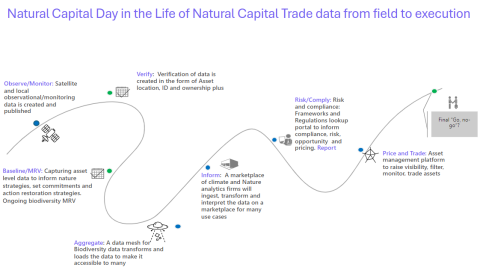The "Showcase of the Art of the Possible" session within the Sustainable Finance live section aimed to illuminate the process of transforming natural capital into tradable assets.
Richard Peers, founder of Responsible Risk, remarked on the complex journey from resource monitoring to trade. He noted that while not everyone needs to navigate every step, there’s a notable lack of understanding of the diverse spectrum of data and decision-making involved in this process.
The presentation was structured to explore each phase of deriving value from nature, with insights from multiple experts.
Observing and Monitoring Natural Resources
Giles D’Souza, strategic business lead in remote sensing and GIS at Planet, shared insights on how satellite imagery enables detailed observation of environmental changes. He emphasized the platform’s capacity to analyze vast areas and track changes over time, citing examples like deforestation in the Amazon and urban development in Indonesia. With a resolution capability of three meters, the technology aids in identifying pristine areas worthy of preservation. D’Souza highlighted the importance of relating satellite data to tangible metrics, such as tree count and biomass, facilitating daily monitoring and supporting effective modeling efforts.
Verifying Nature Monitoring Data
Following D’Souza’s presentation, Donna Lyndsay, strategic market lead for environment and sustainability at Ordnance Survey, addressed the critical need for asset verification. She introduced the concept of “gold pins,” which verify asset location and ownership globally, ensuring that investors are not purchasing stranded assets. Collaborating closely with the Global Legal Entity Identifier Foundation, Lyndsay’s team aims to clarify ownership within the investment areas.
Investing in Nature’s Baseline
Cain Blythe, founder of Ecosulis and Credit Nature, discussed the importance of designing restoration strategies and investment mechanisms. He stressed the collaborative nature of this process, advocating against working in isolation and emphasizing dialogue among stakeholders, including landowners and intermediaries. Blythe noted growing client demands for compliance with net-zero initiatives and frameworks like TNFD and CRSD. He underscored that the journey toward a nature-positive strategy is ongoing and fluid, with no definitive endpoint yet established.
Aggregating Data to Enhance Accessibility
Matthew Sandoe, chief of staff at OS Climate, posed a pivotal question regarding the development of an accessible ecosystem for data. He described their work in transforming raw satellite data into actionable information while prioritizing ease of access, sharing, and trust. The goal is to establish a marketplace that facilitates data aggregation and analytics, empowering banks and asset managers to conduct informed calculations.
Analyzing Nature Risks and Regulatory Challenges
Musidora Jorgensen, chief impact officer at World Wide Generation, discussed the challenges in tracking progress within the assurance and rating landscape. She emphasized the necessity of real-time, reliable, and comparable data to align strategies effectively. According to Jorgensen, companies often experience "carbon tunnel vision," neglecting other critical factors. She highlighted rising global standards, such as CSDDD, which could significantly impact supply chains, stressing the need for automated processes to manage complex data and regulations efficiently.
Valuing Nature as an Investment Asset
The session culminated with Andrew Creak, founder of Kana Earth, addressing the ultimate objective: positioning nature-based projects as viable investment assets. He noted the importance of establishing a valuation that justifies investment decisions. Creak mentioned the need for risk evaluation, particularly in portfolio management, and discussed the implications of future supply and demand trends on asset valuation amid evolving climate risks.
This exploration underscored the multifaceted pathway towards making nature an investable asset class, highlighting the interplay between monitoring, verification, investment strategy development, data accessibility, and risk management.
